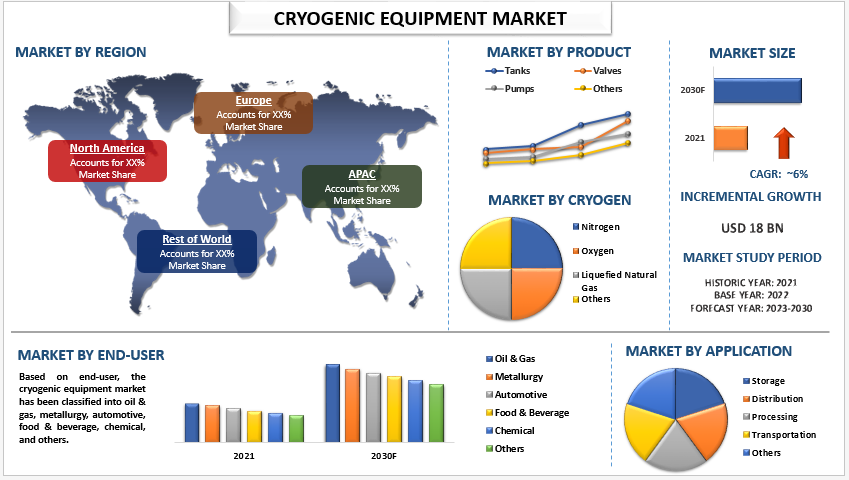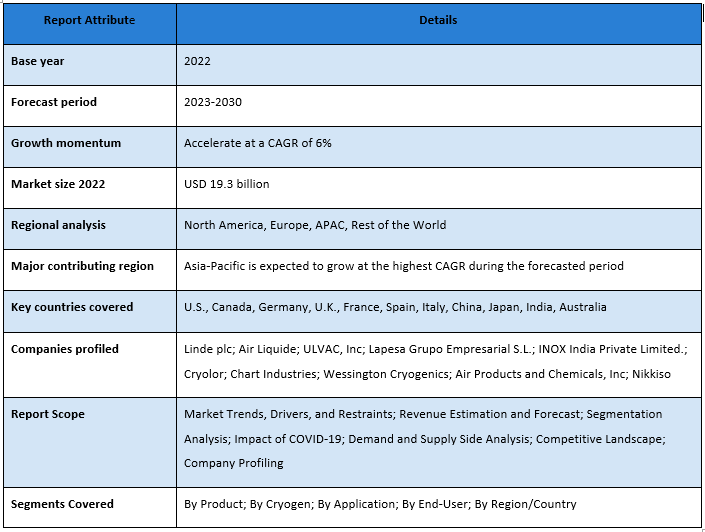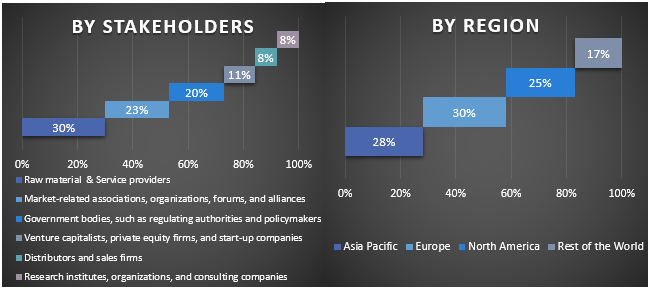Cryogenic Equipment Market: Current Analysis and Forecast (2023-2030)
$3999 – $6999
Emphasis on Product (Tanks, Valves, Pumps, and Others); Cryogen (Nitrogen, Oxygen, Liquefied Natural Gas, and Others); Application (Storage, Distribution, Processing, Transportation, and Others); and End-User (Oil & Gas, Metallurgy, Automotive, Food & Beverage, Chemical, and Others); and Region/Country
| Pages: | 140-160 |
|---|---|
| Table: | 40-60 |
| Figure: | 90-110 |
| Report ID: | UMEP212200 |
| Geography: |

Report Description

Global Cryogenic Equipment Market was valued at USD 19.3 billion in 2022 & is expected to grow at a CAGR of 6% from 2023-2030. Cryogenic Equipment is defined as equipment used in the production, storage, transportation, and distribution of cryogenic fluids, which are liquids that have a temperature below -150°C. Cryogenic fluids include gases such as liquid nitrogen, liquid helium, and liquefied natural gas. Cryogenic equipment is used in a variety of industries, including healthcare, industrial manufacturing, and research. It is used for a variety of applications, such as cooling and freezing, sterilization, and storage of temperature-sensitive materials. Examples of cryogenic equipment include cryogenic tanks, cooling jackets, and liquid nitrogen generators. Factors such as increasing LNG commerce & advancements in cryogenic energy storage systems coupled with growing demand for clean energy sources. Major companies in the market offer cryogenic equipment for multiple uses. For instance, in Sep 2022, President Murmu inaugurated HAL’s new facility to build cryogenic engines for ISRO rockets. Also, in Apr 2023, India’s largest cryogenic equipment manufacturing facility with the ability to fabricate over 20,000 metric tons per year of stainless-steel equipment INOXCVA.
Linde plc; Air Liquide; ULVAC, Inc; Lapesa Grupo Empresarial S.L.; INOX India Private Limited.; Cryolor; Chart Industries; Wessington Cryogenics; Air Products and Chemicals, Inc; Nikkiso are some of the key players in the market. Several M&As along with partnerships have been undertaken by these players to facilitate customers with hi-tech and innovative products/technologies.
Insights Presented in the Report
“Amongst application, storage is expected to grow with a significant CAGR during the forecast period”
On the basis of application, the market is categorized into storage, distribution, processing, transportation, and others. Among these, storage is expected to grow with a significant CAGR during the forecast period. This is mainly due to the high utilization of rapidly freezing vaccines and preserving biological samples like human flesh, oocytes, and muscle leads to the high demand for the product in the market. Furthermore, the entry of global players into emerging markets adds to the growth of the market. For instance, in Feb 2023, Azenta launched Cryo Store Pico, a Novel Automated Cryogenic Storage System Designed for Clinical and Laboratory Applications.
“Amongst end-user, the metallurgy category is expected to grow with a significant CAGR during the forecast period”
Based on end-user, the cryogenic equipment market has been classified into oil & gas, metallurgy, automotive, food & beverage, chemical, and others. The metallurgy category is expected to grow with a significant CAGR during the forecast period. This is mainly due to the extensive usage of argon, oxygen, and nitrogen gases in the metallurgy industry is expected to increase the segment’s growth. Nitrogen is widely used in metallurgy for various purposes including annealing, neutral hardening, sintering, cyanidation, and during blast furnaces. The rising metallurgy and high demand for technical gases drive segment growth. Thus, such factors are increasing the demand for cryogenic equipment in the metallurgy segment.
“APAC is anticipated to grow at a substantial CAGR during the forecast period”
In 2021, APAC is anticipated to grow at a substantial CAGR during the forecast period. This is mainly due to the usage of cryogenic equipment in multiple industries such as oil & gas, metallurgy, automotive, food & beverage, chemical, and many others. Where the use of cryogenic is used for storage and transportation of materials which require low temperature is driving the growth of the market. Moreover, the continuous investment in research and development to improve their cryogenic technologies is further expected to support the market growth.
Cryogenic Equipment Market Report Coverage

Reasons to buy this report:
- The study includes market sizing and forecasting analysis validated by authenticated key industry experts.
- The report presents a quick review of overall industry performance at one glance.
- The report covers an in-depth analysis of prominent industry peers with a primary focus on key business financials, product portfolios, expansion strategies, and recent developments.
- Detailed examination of drivers, restraints, key trends, and opportunities prevailing in the industry.
- The study comprehensively covers the market across different segments.
- Deep dive regional level analysis of the industry.
Customization Options:
The global cryogenic equipment market can further be customized as per the requirement or any other market segment. Besides this, UMI understands that you may have your own business needs, hence feel free to connect with us to get a report that completely suits your requirements.

You can also purchase parts of this report. Do you want to check out a section wise
price list?
Research Methodology
Research Methodology for the Cryogenic Equipment Market Analysis (2023-2030)
Analyzing the historical market, estimating the current market, and forecasting the future market of the global cryogenic equipment market were the three major steps undertaken to create and analyze the adoption of cryogenic equipment in major regions globally. Exhaustive secondary research was conducted to collect the historical market numbers and estimate the current market size. Secondly, to validate these insights, numerous findings and assumptions were taken into consideration. Moreover, exhaustive primary interviews were also conducted, with industry experts across the value chain of the global cryogenic equipment market. Post assumption and validation of market numbers through primary interviews, we employed a top-down/bottom-up approach to forecasting the complete market size. Thereafter, market breakdown and data triangulation methods were adopted to estimate and analyze the market size of segments and sub-segments of the industry pertains to. Detailed methodology is explained below:
Analysis of Historical Market Size
Step 1: In-Depth Study of Secondary Sources:
Detail secondary study was conducted to obtain the historical market size of the cryogenic equipment market through company internal sources such as annual reports & financial statements, performance presentations, press releases, etc., and external sources including journals, news & articles, government publications, competitor publications, sector reports, third-party database, and other credible publications.
Step 2: Market Segmentation:
After obtaining the historical market size of the cryogenic equipment market, we conducted a detailed secondary analysis to gather historical market insights and share for different segments & sub-segments for major regions. Major segments are included in the report as product, cryogen, application, and end-user. Further country-level analyses were conducted to evaluate the overall adoption of testing models in that region.
Step 3: Factor Analysis:
After acquiring the historical market size of different segments and sub-segments, we conducted a detailed factor analysis to estimate the current market size of the cryogenic equipment market. Further, we conducted factor analysis using dependent and independent variables such as various product, cryogen, application, and end-user of cryogenic equipment. A thorough analysis was conducted for demand and supply-side scenarios considering top partnerships, mergers and acquisitions, business expansion, and product launches in the cryogenic equipment market sector across the globe.
Current Market Size Estimate & Forecast
Current Market Sizing: Based on actionable insights from the above 3 steps, we arrived at the current market size, key players in the global cryogenic equipment market, and market shares of the segments. All the required percentage shares split, and market breakdowns were determined using the above-mentioned secondary approach and were verified through primary interviews.
Estimation & Forecasting: For market estimation and forecast, weights were assigned to different factors including drivers & trends, restraints, and opportunities available for the stakeholders. After analyzing these factors, relevant forecasting techniques i.e., the top-down/bottom-up approach were applied to arrive at the market forecast for 2030 for different segments and sub-segments across the major markets globally. The research methodology adopted to estimate the market size encompasses:
- The industry’s market size, in terms of revenue (USD) and the adoption rate of the cryogenic equipment market across the major markets domestically
- All percentage shares, splits, and breakdowns of market segments and sub-segments
- Key players in the global cryogenic equipment market in terms of products offered. Also, the growth strategies adopted by these players to compete in the fast-growing market
Market Size and Share Validation
Primary Research: In-depth interviews were conducted with the Key Opinion Leaders (KOLs) including Top Level Executives (CXO/VPs, Sales Head, Marketing Head, Operational Head, Regional Head, Country Head, etc.) across major regions. Primary research findings were then summarized, and statistical analysis was performed to prove the stated hypothesis. Inputs from primary research were consolidated with secondary findings, hence turning information into actionable insights.
Split of Primary Participants in Different Regions

Market Engineering
The data triangulation technique was employed to complete the overall market estimation and to arrive at precise statistical numbers for each segment and sub-segment of the global cryogenic equipment market. Data was split into several segments & sub-segments post studying various parameters and trends in the areas of product, cryogen, application, and end-user in the global cryogenic equipment market.
The main objective of the Global Cryogenic Equipment Market Study
The current & future market trends of the global cryogenic equipment market were pinpointed in the study. Investors can gain strategic insights to base their discretion for investments on the qualitative and quantitative analysis performed in the study. Current and future market trends determined the overall attractiveness of the market at a regional level, providing a platform for the industrial participant to exploit the untapped market to benefit from a first-mover advantage. Other quantitative goals of the studies include:
- Analyze the current and forecast market size of the cryogenic equipment market in terms of value (USD). Also, analyze the current and forecast market size of different segments and sub-segments
- Segments in the study include areas of product, cryogen, application, and end-user.
- Define and analysis of the regulatory framework for the cryogenic equipment
- Analyze the value chain involved with the presence of various intermediaries, along with analyzing customer and competitor behaviors of the industry.
- Analyze the current and forecast market size of the cryogenic equipment market for the major region.
- Major countries of regions studied in the report include Asia Pacific, Europe, North America, and the Rest of the World.
- Company profiles of the cryogenic equipment market and the growth strategies adopted by the market players to sustain in the fast-growing market
- Deep dive regional level analysis of the industry

You can also purchase parts of this report. Do you want to check out a section wise
price list?
You must be logged in to post a review.



Reviews
There are no reviews yet.